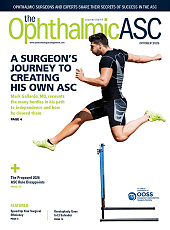The following transcript has been edited for clarity:
Hi, this is Dr. Paul Hahn, and I just gave a talk at the ASRS annual meeting looking at the impact of AREDS vitamin supplements on the growth of geographic atrophy (GA).
This study was motivated by a recent study that was presented and published over the past year. In this prior study, Dr. Tiarnán Keenan and his colleagues, on behalf of the AREDS and AREDS2 research groups, performed a post hoc analysis. In this post hoc analysis they looked at the original AREDS and AREDS2 clinical trials and reevaluated the impact of AREDS vitamin supplements on geographic atrophy. No impact was seen for overall GA growth or for vision loss, but the interesting finding was the positive benefit was seen both for AREDS and AREDS2 vitamins in slowing down the rate of growth of GA, specifically towards the fovea. This specific metric—growth of the atrophy towards the fovea—may arguably be the most important metric, because it’s the fovea that we care most about saving, of course. So this was really exciting, but we need to remind ourselves this finding should be considered hypothesis-generating, because it was a post hoc analysis.
With this excitement we wanted to see if these findings were in fact reproducible, so we turned to OAKS and DERBY. These were the pivotal clinical trials looking at patients treated with pegcetacoplan (Syfovre; Apellis Pharmaceuticals) for geographic atrophy and of course there were untreated eyes—both sham eyes as well as fellow eyes. We performed a parallel analysis to that other post hoc analysis, with a few notable differences. First, the initial AREDS and AREDS2 clinical trials had thousands of patients enrolled, but most of these had earlier stages of macular degeneration and did not have geographic atrophy, which was the disease of interest here. So, in their post hoc analysis of these initial AREDS and AREDS2 clinical trials they looked at about 200 to 500 patients, depending on which arm was studied in that analysis. On the other hand, OAKS and DERBY, of course, only included patients with geographic atrophy, so the numbers were actually much greater, with 500 to 1,200 patients in the different arms in this post hoc analysis. The other main difference was the imaging. In AREDS and AREDS2, which are now decades-old studies, geographic atrophy was monitored and identified with color fundus photography, which was the gold standard at that time. Since then, that standard has shifted. Now we typically rely on a multimodal approach, primarily with fundus autofluorescence, and this was the imaging used in OAKS and DERBY.
So with this in mind, what did we find? Unfortunately, we were unable to find any effect of AREDS or AREDS2 vitamin supplementation on any of our endpoints. Specifically, unlike the exciting finding seen in that initial AREDS and AREDS2 study, which identified positive benefit with AREDS vitamins towards growth towards the fovea, we did not reproduce this in our analysis of OAKS and DERBY. Similarly, we did not find any beneficial effect on vision loss or on growth of overall atrophy. We also wanted to see whether AREDS vitamins may help augment the beneficial effect of pegcetacoplan on geographic atrophy growth and we also did not see any beneficial or harmful effect. Finally, we thought that perhaps AREDS vitamins may have some modulatory effect on the rate of exudative macular degeneration that’s seen as a side effect of pegcetacoplan treatment. Along the same lines, we did not see any effect of AREDS vitamin supplementation on the development of exudative AMD.
So in summary, unlike the post hoc analysis of the initial AREDS and AREDS2 studies, our post hoc analysis of OAKS and DERBY could not identify any meaningful benefit of AREDS vitamin supplementation on GA growth, even in the specific metric that showed benefit in that initial study, which was growth towards the fovea. It would have been fantastic if we did have an oral, easily accessible means of treating geographic atrophy, but our analysis suggests that we still have work to do, with further exploration needed. Thanks for your attention. RP








